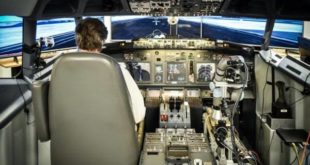In an era where global security relies on staying one step ahead of ever-evolving threats, the maritime domain poses unique challenges. Surface warships are tasked with ensuring safe navigation, safeguarding maritime boundaries, and countering a myriad of potential dangers. To tackle these challenges head-on, a revolutionary shift is underway: the …
Read More »DARPA’s Marconi Project: Pioneering Advances in Military Communication Beyond Limits
Introduction The United States Defense Advanced Research Projects Agency (DARPA) has taken a significant step forward with its Macaroni project, issuing a broad agency announcement that calls for the development of groundbreaking RF receivers, transmitters, and antennas. This ambitious initiative aims to revolutionize RF and microwave technology, propelling communication and …
Read More »Next-Gen Avionics: Transforming Aviation Safety, Performance, and Situational Awareness
Introduction Avionics, the electronic systems integrated into aircraft, are at the forefront of a revolution in aviation. These systems have evolved significantly, with a primary focus on enhancing safety, improving efficiency, and delivering unprecedented situational awareness. In this article, we will explore the latest trends and innovations in both commercial …
Read More »DARPA’s PALS Program: Unveiling the Future of Underwater Surveillance with Living Naval Sensors
Introduction In the vast expanse of the world’s oceans, monitoring adversaries’ movements has always posed a significant challenge. Recognizing the need for innovative solutions, the Defense Advanced Research Projects Agency (DARPA) introduced the Persistent Aquatic Living Sensors (PALS) program in February 2018. This groundbreaking initiative aims to integrate the power …
Read More »Gallium Nitride (GaN): Revolutionizing Aerospace and Military Communications, Radar, and Electronic Warfare (EW) Applications
The landscape of integrated circuits and power devices is undergoing a remarkable transformation with the emergence of Gallium Nitride (GaN) technology, a wide bandgap semiconductor material. Historically, the semiconductor industry relied heavily on silicon-based technology, but as demands for higher power density and energy efficiency surge across applications including advanced …
Read More »Unleashing the Power: Demystifying Power MOSFETs in SMPS Design
Introduction Switch-mode power supplies (SMPS) are the backbone of modern electronics, enabling efficient and reliable power conversion. At the heart of every SMPS lies a key component known as the Power MOSFET. These devices play a critical role in regulating and controlling the flow of electrical power. In this article, …
Read More »Optical MEMS or MOEMS Enabling Advanced Technologies: Augmented Reality, Mini-Spectrometers, Lidar, and Wearable Healthcare
Introduction The rapid progress in modern microelectronics has resulted in impressive computational and memory capabilities. However, bridging the gap between digital systems and the physical world has remained a challenge. This is where MicroElectroMechanical Systems (MEMS) and even smaller Nano ElectroMechanical Systems (NEMS) come into play. These technologies integrate sensors …
Read More »Immersive Audio Unleashed: Exploring the Wonders of Ambisonics
Introduction: In the realm of audio technology, innovation never ceases to amaze us. From mono to stereo, surround sound, and now, we find ourselves immersed in a new era of audio realism with a technology known as Ambisonics. Ambisonics has rapidly gained popularity in recent years, revolutionizing the way we …
Read More »Light Emitting Switches: Illuminating the Future of Control Systems
Introduction: In the realm of electronic devices and control systems, innovation knows no bounds. One such groundbreaking development transforming how we interact with technology is the advent of light-emitting switches. Combining the functionality of traditional switches with the mesmerizing glow of light emission, these switches offer a host of advantages …
Read More »Unveiling the Evolution of Microphone Technology: From Fundamentals to Cutting-Edge Innovations in Beamforming
Introduction: In today’s fast-paced world, microphone technology has become an integral part of our daily lives. From communication devices to recording studios, microphones play a crucial role in capturing and transmitting audio. Over the years, these humble audio devices have undergone a remarkable evolution, revolutionizing the way we capture sound. …
Read More » International Defense Security & Technology Your trusted Source for News, Research and Analysis
International Defense Security & Technology Your trusted Source for News, Research and Analysis



